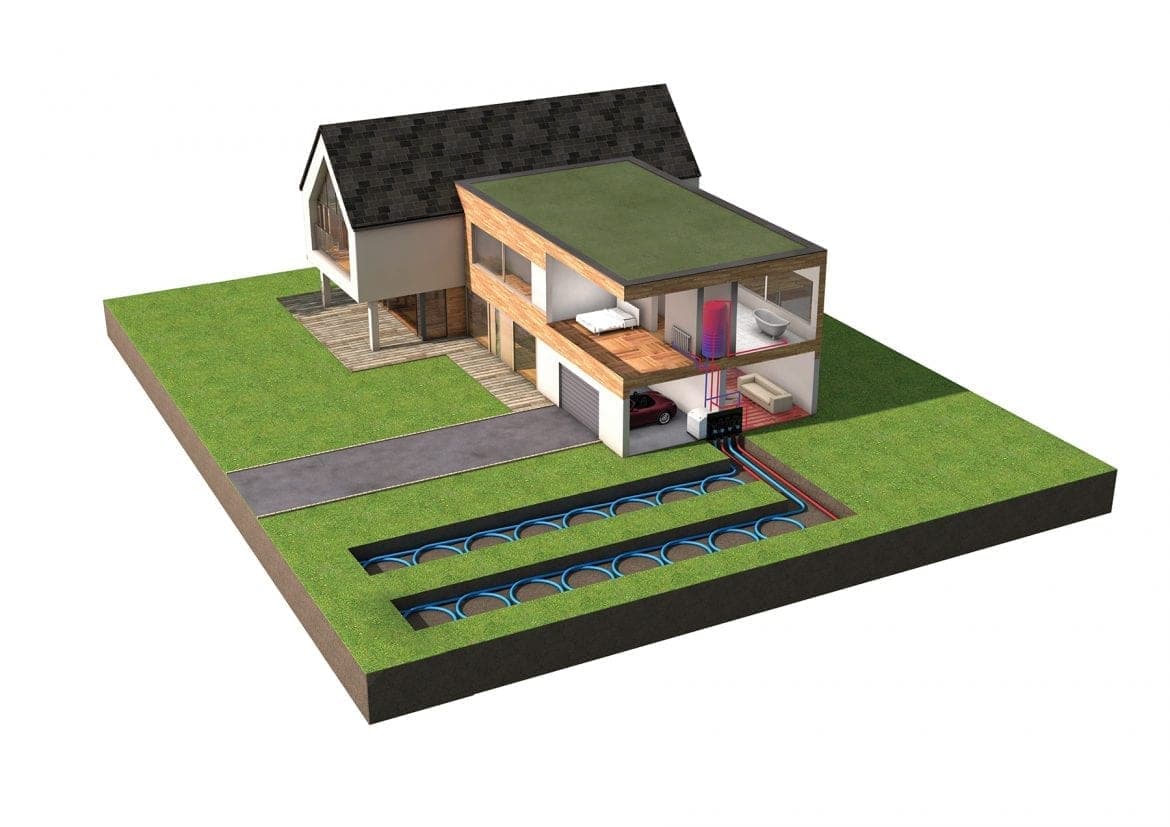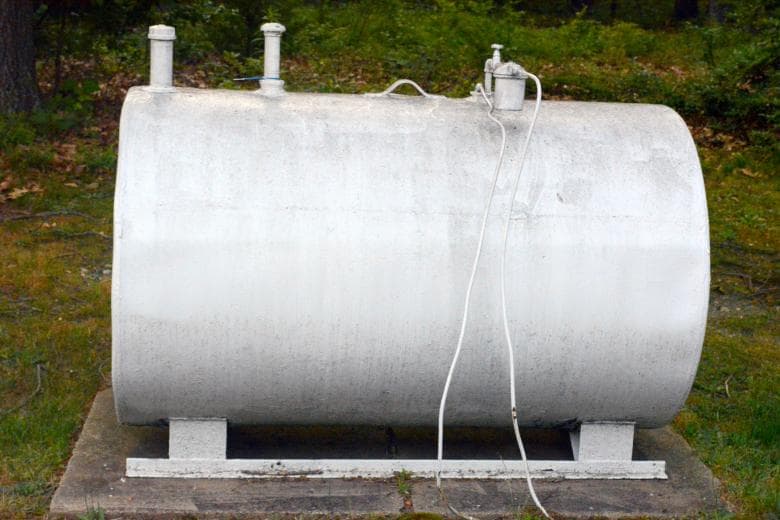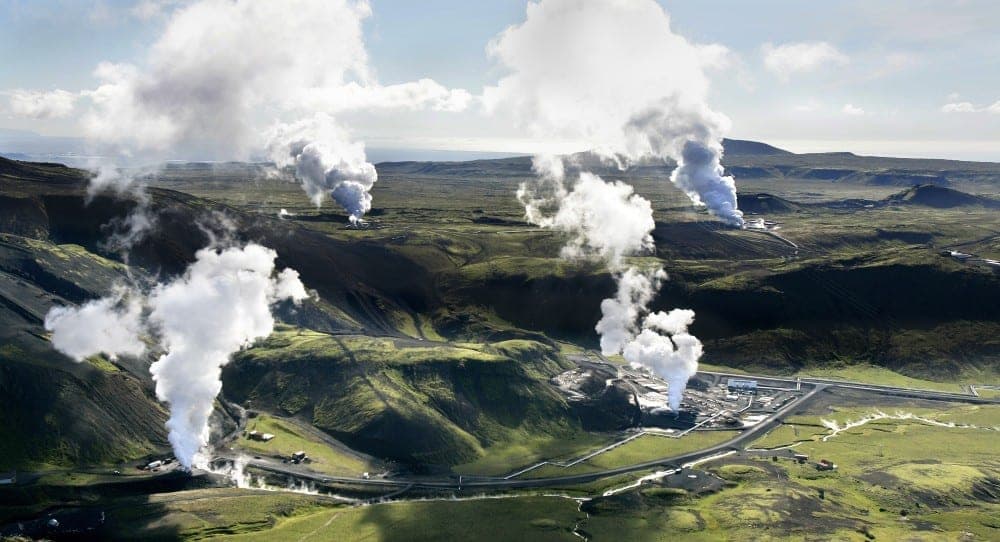What is a heat pump?
In brief, a ground source heat pump will:

A ground source heat pump delivers the best low-carbon heating. It’s an affordable and eco-friendly alternative to fossil fuels such as gas, oil and LPG, which typically contribute to carbon emissions, air pollution and ultimately, play a part in climate change and global warming
Achieving a net-zero carbon future: Heating and hot water make up 25% of total energy use in British homes, equating to 15% of our greenhouse gas emissions.¹ To reduce the UK’s carbon emissions, the best heating systems are being encouraged by the government.
This starts with the ban of fossil-fuel heating in domestic new-build properties from 2025 – forming a part of the government’s plans to achieve net-zero by 2050. Gas and oil boilers are some of the fossil fuel systems that the government is banning from 2025.
In brief, a ground source heat pump will:
The advantages of ground source heat pumps vs. other heating systems include:
Having a ground source heat pump means the property is much more energy efficient and less reliant on fossil fuels.
As gas is a fossil fuel, it releases carbon dioxide (CO2) – a greenhouse gas that contributes to climate change. To achieve the UK’s legally binding target of net-zero carbon emissions by 2050, it’s vital that fossil fuels, including natural gas, are phased out and replaced with renewable alternatives. Delivering a whopping 77% saving on emissions versus gas, see how ground source heating compares to the familiar boiler. Heat pumps are 0% rated on VAT too.
Although both air source and ground source heat pumps are renewable alternatives to fossil fuels, they hugely differ in efficiency, running costs, carbon savings and durability.
Unlike air source heat pumps, the inherent efficiency of ground source heat pumps means they can deliver the lowest running costs of any type of heating system.
Some people have proposed switching from gas to hydrogen, but in reality it’s not easy or straightforward to convert the gas network to hydrogen and there is no proven blueprint for this solution.
What happens in the next decade could be the measure of success or failure in achieving net-zero carbon. The longer we wait for hydrogen to create a solid solution, the closer we are to the tipping point.
Ground source has greater potential to decarbonise heating and; even better, it is tried and tested and ready to deploy right now.
A hybrid heat pump system, also known as a dual fuel system, couples renewable energy with fossil fuels to provide heating and hot water to a home. A hybrid can be made up of a heat pump and a fossil fuel heating system, but in this context, we’ll look at how a hybrid – made up of an air source heat pump component and a gas boiler component – compares to a single ground source heat pump system.
A hybrid heat pump system is designed to meet the building’s heating and hot water requirements, whilst reducing carbon emissions through the use of renewables. It involves the installation of both the fossil fuel heating system component and the heat pump component.
Firstly, how exactly does a hybrid heat pump work? Hybrid systems can have flexible heating modes, which include:
It’s important to consider all of the costs associated with a hybrid heat pump, including initial, operating and replacement costs. This is important when comparing the technology to a singular ground source heat pump, as ground source tends to be cheaper in the long run.
Oil and liquefied petroleum gas (LPG) is traditionally the go-to alternative fuel for buildings that are not connected to mains gas. However, prices of oil continue to fluctuate against a backdrop of growing global concerns – particularly energy security.
Meanwhile, heat pump technology has evolved, along with accessible funding streams and affordable running costs. Ground source heat pumps have therefore become a more viable and preferred option for off-gas areas.
Add to this the pressure of government plans to ban fossil-fuel heating systems in new builds from 2025, and it looks like oil and LPG boilers could be phased out entirely by 2050.

Vulnerable to energy price hikes and fluctuations, bulky and unsightly fuel storage tank, highly flammable, reliance on fuel deliveries, possibility of fuel theft, pay for the energy upfront all in one go, complicated installation, contributes to air pollution through the emission of particulates, Nitrogen Oxide (NOx) & Sulphur Oxide (SOx), high carbon content.
The savings on our energy bills compared with oil is fantastic and our house value has increased as a result of the installation - we’re over the moon!
Using the carbon intensity factors proposed for SAP 10, an oil boiler emits almost five times as much carbon as a ground source heat pump.
In terms of carbon emissions, there is no justification for the use of oil or LPG boilers when far more appealing and renewable heating options are available. This is why the government is phasing out oil boilers in favour of lower carbon renewable heating systems such as ground source heat pumps.
Yes. For older properties that are not especially well insulated, Kensa will help you to establish whether the existing heating system and existing insulation levels will be compatible with a ground source heat pump, or if your heating distribution system and energy efficiency measures require any upgrades.
If you are undecided on whether you should upgrade your radiators or insulation levels, you can run a trial over a heating season. To do this, we recommend you turn down the flow temperature of your existing boiler to 50°C and run the system through the winter heating season to mimic the output of a ground source heat pump system.
If you find you can maintain your required comfort conditions at this lower flow temperature, then you have proved that your existing heating distribution system and the current heat loss of your property is compatible with a ground source heat pump installation – without any upgrades required. If you were not satisfied with the comfort levels then we advise you to upgrade your radiators, and improve the insulation levels in the property prior to installing a ground source heat pump.
There is often much confusion when it comes to comparing ground source heat pumps to geothermal heating. Some people use the terms interchangeably, but there are key differences.
Ground source heat pumps, like those manufactured by Kensa Heat Pumps, generally take heat from 1.2m – 200m depths. In this zone, there is a large amount of low-grade energy available, which needs a heat pump to upgrade this to more useful temperatures.
The reason geothermal heating is often confused with ground source heating is that both ultimately harness heat energy from the ground to provide heating and hot water to buildings.
However, the main differences are where the heat originates and the application the heat will be used for.

Geothermal heat comes from the earth’s core; ‘geothermal’ literally means ‘earth’s heat’. It uses heat directly from drilling deep or shallow sources emanating from the earth’s core, such as hot springs, geysers and volcanic hot spots.
Borehole drilling for geothermal heating can often be drilled to depths many kilometers below the ground. In the UK, you have to go down 500m – 2500m before there is any appreciable input from the earth’s core. Geothermal typically needs to be deployed at large scales to make it financially viable.
Geothermal systems operate at temperatures of 120°C – 300°C and therefore do not necessarily need a heat pump to upgrade the heat, nor a ground loop system.
Large-scale plants and communities tend to use geothermal energy over ground source heat pumps.
When you drill a deep geothermal hole, it’s not always clear what the conditions will be like further down. Inevitably, this could determine how well the system will work.
However, ground source heat pumps absorb energy at shallower depths, which means there is a much higher level of certainty around the conditions you will find.
The following terms are sometimes used when referring to ground source heat pump installations, and can be misleading and technically inaccurate due to their ‘geothermal’ references:
Space required for fuel storage, reliance on regular fuel deliveries, high maintenance compared to ground source heat pumps, planning permission required due to emissions, contributes to air pollution through the emission of particulates, Nitrogen Oxide (NOx) & Sulphur Oxide (SOx).
1. UK housing: Fit for the future? Committee on Climate Change, 2019
2. Hydrogen for Heating? Prof. David Cebon, University of Cambridge, as cited in Hydrogen: a decarbonisation route for heat in buildings? LETI, 2021
3. Is hydrogen the solution to net-zero home heating? The Guardian, 2020
4. Hydrogen: a decarbonisation route for heat in buildings? LETI, 2021
5. What is a Hybrid Heating System? Boiler guide
6. Hybrid heat pumps final report, BEIS, published 2018
7. What is a Hybrid (Dual Fuel) Heat Pump System? IMS Heat Pumps
8. Hybrid heat pumps final report, BEIS, published 2018